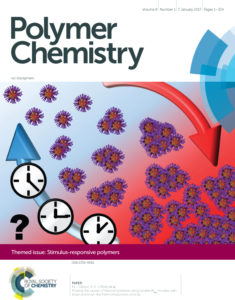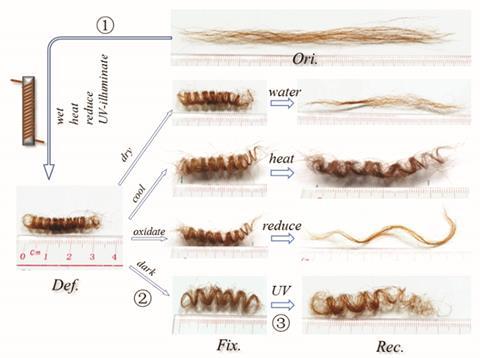
Tom Davis is a member of Advisory Board for Polymer Chemistry and the Monash–Warwick Professor of medical nanotechnology at Monash University, Australia. Prof. Davis’ research focuses on the application of polymer science and nanotechnology to therapeutic applications, and enhancing the fundamental understanding of how nanomaterials interact with biological systems.

Nghia Truong is a member of the RSC Advances Reviewer Panel and a research fellow at Monash University, Australia. His research focuses on engineering the size, shape, surface, core, and function of polymeric nanoparticles for applications in nanomedicine, using a variety of techniques including emulsion polymerization, self-assembly, polymerization-induced self-assembly, temperature-induced morphological transformation, and click chemistry.
You can find all Advisory Board’s Top Picks papers in our web collection.
Focus on nanoparticle shapes (Prof. Tom Davis, Monash University, Australia and Dr. Nghia Truong, Monash University, Australia).
Shape plays an important role in functional properties of nanoparticles, and as a result, their utility in many applications. Polymer chemists with powerful synthetic techniques have recently made significant contributions expanding our ability to make complex nano-shapes. In 2016, many excellent Polymer Chemistry publications have appeared describing the synthesis and assembly of polymers into tertiary structures. Below we highlight some that have caught our eye.
1. Multicompartment morphologies self-assembled from fluorinated ABC triblock terpolymers: the effects of flexible and rigid hydrophobic moieties
Sen Li, Jinlin He, Mingzu Zhang, Hairong Wang and Peihong Ni
Polym. Chem., 2016, 7, 1773–1781
Li et. al. self-assemble fluorinated triblock terpolymers into five types of reproducible shapes including sphere, tube, rod, hamburger, and flower. Interestingly, rod-like aggregates have a uniform zig-zag pattern. This work reveals the fact that flexibility or rigidity of hydrophobic segment and polymer concentration have a big influence on the shape of nanoparticles.
2. Disk-like micelles with cylindrical pores from amphiphilic polypeptide block copolymers
Xue Lin, Xiaohua He, Chaoqun Hu, Yuxiang Chen, Yiyong Mai and Shaoliang Lin
Polym. Chem., 2016, 7, 2815–2820
A rare and complex shape such as a nanodisk with cylindrical pores has recently been achieved by self-assembly of the amphiphilic block copolypeptide poly(ethylene glycol)-block-poly(γ-benzyl-L-glutamate) (PEG-b-PBLG) in solution. Spherical micelles and vesicles can also be prepared by tuning the ratio between the hydrophilic block and hydrophobic block in PEG-b-PBLG copolymers.
3. Salicylaldehyde-functionalized block copolymer nano-objects: one-pot synthesis via polymerization-induced self-assembly and their simultaneous cross-linking and fluorescence modification
Jianbing Huang, Hanjun Zhu, Hui Liang and Jiang Lu
Polym. Chem., 2016, 7, 4761–4770
Beside traditional self-assembly, RAFT-mediated emulsion and dispersion polymerization is a very useful technique to simultaneously synthesise block copolymers and form nanoparticles with different shapes. Using this technique, Huang et. al. can crosslink and functionalise spheres, worms, and vesicles with salicylaldazine moieties. These moieties endow the nano-objects with strong orange fluorescence in water, organic solutions or solid state via an aggregation-induced emission mechanism.
4. Microwave-assisted synthesis of block copolymer nanoparticles via RAFT with polymerization-induced self-assembly in methanol
Elden T. Garrett, Yiwen Pei and Andrew B. Lowe
Polym. Chem., 2016, 7, 297–301
Andrew Lowe and coworkers have reported the use of microwaves to further assist RAFT-mediated dispersion polymerization and the formation of nanoparticles with various shapes. The work shows the benefits of microwave-assisted syntheses of nanoparticles in alcoholic solvents.
5. Addition of water to an alcoholic RAFT PISA formulation leads to faster kinetics but limits the evolution of copolymer morphology
E. R. Jones, M. Semsarilar, P. Wyman, M. Boerakker and S. P. Armes
Polym. Chem., 2016, 7, 851–859
Besides using a microwave, the addition of water into alcoholic solvents also increases the rate of RAFT-mediated dispersion polymerization. On the other hand, Armes and coworkers find that in the presence of water, only kinetically-trapped spheres are obtained. This work and other works using aqueous RAFT-mediated emulsion polymerizations create a currently unclear question about the mechanism of the in-situ formation of various nanoparticle shapes in water.
Review article
Theoretical simulations of nanostructures self-assembled from copolymer systems
Zhanwen Xu, Jiaping Lin, Qian Zhang, Liquan Wang and Xiaohui Tian
Polym. Chem., 2016, 7, 3783–3811
Beside powerful synthetic techniques, theoretical simulations offer a useful approach for the understanding and prediction of the formation of polymeric nanostructures. The review by Xu et al. gives a nice overview of the simulation investigations of many self-assembled nanostructures. By tailoring the molecular architectures of block copolymers, nanoparticles with desired shapes can be achieved. Challenges and further developments for theoretical simulations are also discussed in this useful review.














